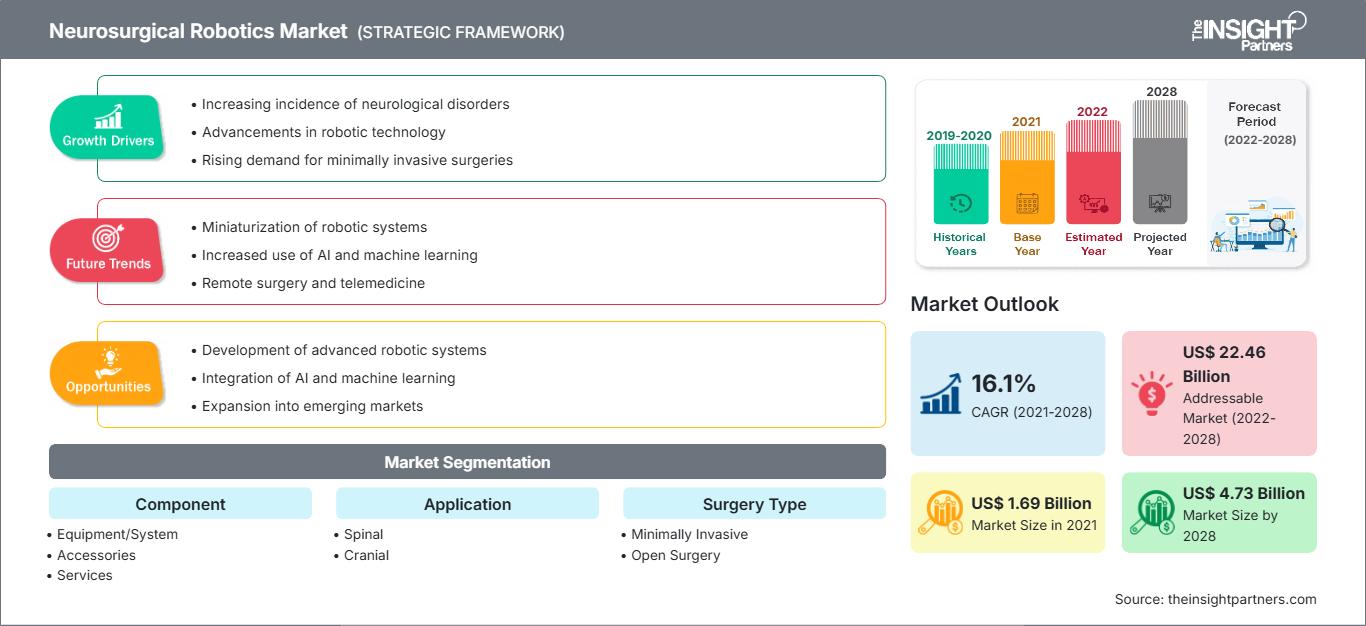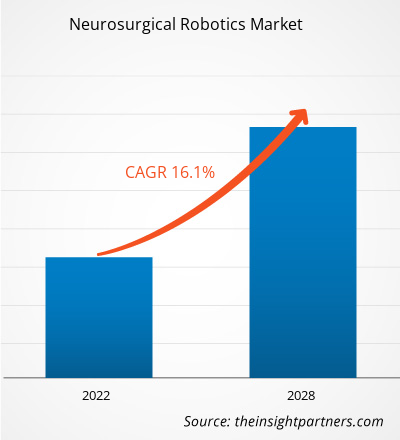Der Markt für neurochirurgische Robotik soll von 1.691,02 Millionen US-Dollar im Jahr 2021 auf 4.729,86 Millionen US-Dollar im Jahr 2028 wachsen. Von 2022 bis 2028 wird mit einer durchschnittlichen jährlichen Wachstumsrate (CAGR) von 16,1 % gerechnet.
Ein Roboter ist ein automatisches mechanisches Gerät, das oft einem Menschen oder Tier ähnelt. Moderne Roboter sind in der Regel elektromechanische Maschinen, die von einem Computerprogramm oder elektronischen Schaltkreisen gesteuert werden. Roboter können autonom oder halbautonom sein und reichen von Humanoiden wie Hondas Advanced Step in Innovative Mobility (ASIMO) und TOSYs TOSY Ping Pong Playing Robot (TOPIO) über Industrieroboter und kollektiv programmierte Schwarmroboter bis hin zu mikroskopisch kleinen Nanorobotern. In den letzten 20 Jahren haben neurochirurgische Roboter zunehmend bei neurochirurgischen Eingriffen assistiert. In den letzten Jahren wurden neurochirurgische Roboter für verschiedene Eingriffe entwickelt. Die öffentliche Nachfrage prägt die Ausrichtung der Neurochirurgie und erhöht den Druck auf Neurochirurgen, neurochirurgische Roboter einzusetzen. Die zunehmende Vielfalt und Komplexität neurochirurgischer Roboter wird aufgrund möglicher chirurgischer Komplikationen und der zukünftigen Rolle von Robotern ethisch hinterfragt.
Der Bericht bietet Einblicke und eine detaillierte Analyse des globalen Marktes für neurochirurgische Roboter und beleuchtet verschiedene Parameter, darunter Markttrends, technologische Fortschritte, Marktdynamik und eine Analyse der Wettbewerbslandschaft der weltweit führenden Marktteilnehmer. Er berücksichtigt auch die Auswirkungen der COVID-19-Pandemie auf den Markt in allen Regionen. Die Auswirkungen von COVID-19 auf den Markt für neurochirurgische Roboter waren insgesamt gemischt; daher gewinnt der Markt weiterhin an Dynamik und wird in den kommenden Jahren voraussichtlich wachsen. Die Gesundheitssysteme waren überlastet, und die medizinische Versorgung aller Patienten in der Region ist zu einer Herausforderung geworden. Auch die Medizintechnikbranche war mit den negativen Auswirkungen der Pandemie konfrontiert. Mit fortschreitender COVID-19-Pandemie gerieten Medizintechnikunternehmen in Schwierigkeiten, ihren Betrieb aufrechtzuerhalten. Viele Unternehmen der neurochirurgischen Robotik waren in den USA tätig und litten unter den Auswirkungen des großflächigen COVID-19-Ausbruchs. Nach der Normalisierung der pandemiebedingten Einschränkungen normalisierte sich die Zahl der chirurgischen Eingriffe jedoch wieder. Nach und nach nahmen Krankenhäuser wieder Wahleingriffe auf, da die Genesungsrate von COVID-19 die Nachfrage nach medizinischer Ausrüstung wie neurochirurgischen Robotern erhöhte.
Passen Sie diesen Bericht Ihren Anforderungen an
Sie erhalten kostenlos Anpassungen an jedem Bericht, einschließlich Teilen dieses Berichts oder einer Analyse auf Länderebene, eines Excel-Datenpakets sowie tolle Angebote und Rabatte für Start-ups und Universitäten.
Markt für neurochirurgische Robotik: Strategische Einblicke

-
Holen Sie sich die wichtigsten Markttrends aus diesem Bericht.Dieses KOSTENLOSE Beispiel umfasst Datenanalysen, die von Markttrends bis hin zu Schätzungen und Prognosen reichen.
Geografiebasierte Erkenntnisse
Geografisch ist der globale Markt für neurochirurgische Robotik in Nordamerika (USA, Kanada und Mexiko), Europa (Frankreich, Deutschland, Großbritannien, Spanien, Russland, Italien und das übrige Europa), den asiatisch-pazifischen Raum (China, Indien, Japan, Australien, Südkorea, Kasachstan und der restliche Asien-Pazifik-Raum), den Nahen Osten und Afrika (Saudi-Arabien, die Vereinigten Arabischen Emirate, Südafrika und der restliche Nahe Osten) sowie Süd- und Südamerika unterteilt. Mittelamerika (Brasilien, Argentinien und der Rest von Süd- und Mittelamerika).
Markteinblicke
Steigende Anzahl neurochirurgischer Eingriffe
Die zunehmende Häufigkeit neurologischer Erkrankungen wie Epilepsie, Parkinson, Kopfverletzungen, Hirntumore, Schlaganfall und Hydrozephalus erhöht den Bedarf an neurochirurgischen Eingriffen. Darüber hinaus gehören verschiedene Unterdisziplinen der Neurochirurgie wie pädiatrische Neurochirurgie, funktionelle Neurochirurgie, neurovaskuläre Chirurgie, Traumatologie, Schädelbasischirurgie und Wirbelsäulenchirurgie zu den technisch anspruchsvollsten und anspruchsvollsten Bereichen der Chirurgie.
Laut einem Artikel mit dem Titel „Betonung der Rolle der Neurochirurgie im globalen Gesundheitswesen und in nationalen Gesundheitssystemen“ Wie 2021 in Frontiers Media SA veröffentlicht wurde, benötigen aufgrund der zunehmenden Zahl traumatischer Hirnverletzungen (TBI) und Hydrozephalus jährlich 22,6 Millionen Menschen weltweit neurologische Versorgung. Von diesen Patienten benötigen 13,8 Millionen eine Neurochirurgie. Laut den von den Centers for Disease Control and Prevention (CDC) veröffentlichten Daten verzeichneten die USA im Jahr 2019 rund 223.135 TBI-bedingte Krankenhauseinweisungen und im Jahr 2020 64.362 TBI-bedingte Todesfälle. Laut einem 2022 in The Lancet veröffentlichten Artikel mit dem Titel „Der zukünftige Forschungspfad bei traumatischen Hirnverletzungen“ werden jedes Jahr weltweit mehr als 27 Millionen neue TBI-Fälle gemeldet. TBI können mit neurochirurgischen Eingriffen behandelt werden. Daher treiben die steigenden TBI-Fälle aufgrund verschiedener Faktoren, darunter Stürze, Sportverletzungen, Verkehrsunfälle, häusliche Gewalt und militärische Zwischenfälle, die Nachfrage nach neurochirurgischen Eingriffen in die Höhe.
Laut Daten der Weltgesundheitsorganisation (WHO) vom Juni 2022 leiden weltweit rund 50 Millionen Menschen an Epilepsie, und Epilepsie ist eine der häufigsten neurologischen Erkrankungen. Fast 80 % der Epilepsiepatienten leben in Ländern mit niedrigem und mittlerem Einkommen. Darüber hinaus Schätzungsweise 5 Millionen Menschen werden jedes Jahr mit Epilepsie diagnostiziert. Patienten, die schlecht auf die medikamentöse Behandlung ansprechen, werden operiert. Die zunehmende Zahl von Epilepsiefällen treibt daher den Bedarf an neurochirurgischen Eingriffen voran. Die steigende Zahl neurochirurgischer Eingriffe treibt somit das Wachstum des Marktes für neurochirurgische Robotik voran.
Komponentenbasierte Erkenntnisse
Basierend auf den Komponenten ist der globale Markt für neurochirurgische Robotik in Geräte, Zubehör und Dienstleistungen segmentiert. Im Jahr 2021 hatte das Zubehörsegment den größten Marktanteil. Es wird jedoch erwartet, dass das Dienstleistungssegment von 2022 bis 2028 die höchste durchschnittliche jährliche Wachstumsrate (CAGR) im Markt verzeichnet.
Anwendungsbasierte Erkenntnisse
Basierend auf der Anwendung ist der globale Markt für neurochirurgische Robotik in Wirbelsäulen- und Schädelchirurgie unterteilt. Das Wirbelsäulensegment hatte 2021 einen größeren Marktanteil und wird voraussichtlich eine schnellere CAGR verzeichnen. während des Prognosezeitraums.
Markt für neurochirurgische Robotik
Die Analysten von The Insight Partners haben die regionalen Trends und Faktoren, die den Markt für neurochirurgische Robotik im Prognosezeitraum beeinflussen, ausführlich erläutert. In diesem Abschnitt werden auch die Marktsegmente und die geografische Lage in Nordamerika, Europa, dem asiatisch-pazifischen Raum, dem Nahen Osten und Afrika sowie Süd- und Mittelamerika erörtert.Umfang des Marktberichts zur neurochirurgischen Robotik
| Berichtsattribut | Einzelheiten |
|---|---|
| Marktgröße in 2021 | US$ 1.69 Billion |
| Marktgröße nach 2028 | US$ 4.73 Billion |
| Globale CAGR (2021 - 2028) | 16.1% |
| Historische Daten | 2019-2020 |
| Prognosezeitraum | 2022-2028 |
| Abgedeckte Segmente |
By Komponente
|
| Abgedeckte Regionen und Länder |
Nordamerika
|
| Marktführer und wichtige Unternehmensprofile |
|
Dichte der Marktteilnehmer für neurochirurgische Robotik: Verständnis ihrer Auswirkungen auf die Geschäftsdynamik
Der Markt für neurochirurgische Robotik wächst rasant. Die steigende Nachfrage der Endnutzer ist auf Faktoren wie veränderte Verbraucherpräferenzen, technologische Fortschritte und ein stärkeres Bewusstsein für die Produktvorteile zurückzuführen. Mit der steigenden Nachfrage erweitern Unternehmen ihr Angebot, entwickeln Innovationen, um den Bedürfnissen der Verbraucher gerecht zu werden, und nutzen neue Trends, was das Marktwachstum weiter ankurbelt.
- Holen Sie sich die Markt für neurochirurgische Robotik Übersicht der wichtigsten Akteure
Endnutzerbasierte Erkenntnisse
Basierend auf den Endnutzern ist der globale Markt für neurochirurgische Robotik in Krankenhäuser, Fachzentren und andere segmentiert. Das Segment Krankenhäuser hatte 2021 den größten Marktanteil. Es wird erwartet, dass dasselbe Segment von 2022 bis 2028 die höchste durchschnittliche jährliche Wachstumsrate (CAGR) verzeichnet.
Die globalen Akteure auf dem Markt für neurochirurgische Robotik verfolgen organische Strategien, einschließlich Produkteinführung und -erweiterung, um ihre Präsenz und ihr Produktportfolio weltweit zu erweitern und die wachsende Nachfrage zu decken. Die wichtigsten Akteure auf dem Markt sind Globus Medical, Inc., Renishaw plc, Accuray Incorporated, NuVasive, Inc, Brainlab AG, Zimmer Biomet, Synaptive Medical, Inc., Medtronic, Brain Navi Biotechnology Co., Ltd., B. Braun Melsungen AG.
- Historische Analyse (2 Jahre), Basisjahr, Prognose (7 Jahre) mit CAGR
- PEST- und SWOT-Analyse
- Marktgröße Wert/Volumen – Global, Regional, Land
- Branchen- und Wettbewerbslandschaft
- Excel-Datensatz
Aktuelle Berichte
Verwandte Berichte
Erfahrungsberichte
Grund zum Kauf
- Fundierte Entscheidungsfindung
- Marktdynamik verstehen
- Wettbewerbsanalyse
- Kundeneinblicke
- Marktprognosen
- Risikominimierung
- Strategische Planung
- Investitionsbegründung
- Identifizierung neuer Märkte
- Verbesserung von Marketingstrategien
- Steigerung der Betriebseffizienz
- Anpassung an regulatorische Trends






















 Kostenlose Probe anfordern für - Markt für neurochirurgische Robotik
Kostenlose Probe anfordern für - Markt für neurochirurgische Robotik